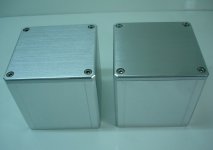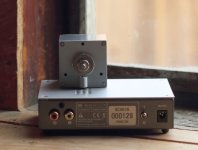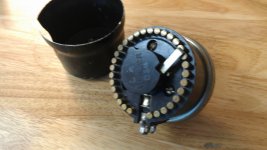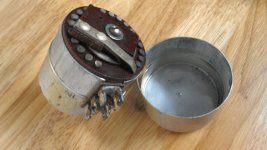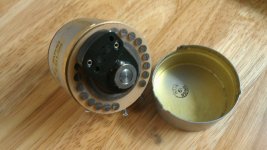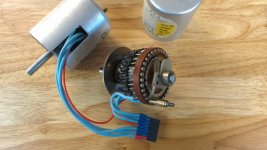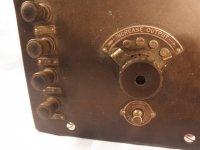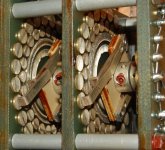And which switch case would that be then ?
It's the one under "Attenuator 41 step." Their photographs are old. The one I showed represents what's currently shipping. Oh, and it's actually 40 steps. Some people get their steps and positions confused.
se
Totally off topic, but related to the bashing from yesterday, for the curious, here is an introduction to NMR. Note the resonance of water is dependent on the magnetic field strength. (Also note the proton references!)
You screwed up the link, not that NMR is even vaguely relevant.
The one I showed
The new model looks pretty, but for completely sealing off the inside, the ridges are too low, imo.
TKD's enclosed switches and attenuator models are totally useless, due to open seams.
Single well-enclosed commercial attenuator switch is the Khozmo's SMD model.
More effective would be to take out part of the bottom of an injection molded aluminum transformer cover, and mount it over the switch to the front panel, with a seal on both sides. Those cost less than 10 bucks each.
(tap 2 holes for grease nipples, and the inside can be vacuumed for an air exchange).
Attachments
Last edited:
Not sure what you mean by "the ridges are too low."
And as far as I'm aware, Khozmo doesn't make an SMD model anymore. Also as far as I'm aware, the Khozmos are all configured as "shunt" attenuators.
The transformer cans could work, though I'd just as soon put some sealant over the seams.
se
And as far as I'm aware, Khozmo doesn't make an SMD model anymore. Also as far as I'm aware, the Khozmos are all configured as "shunt" attenuators.
The transformer cans could work, though I'd just as soon put some sealant over the seams.
se
"Protuding Edge" better ?
(oew, and what an arousing term is that, almost as good as vibrating protons)
True, but merely illustrating that it's still a custom diy job, no all-in-one solutions.
(I reside at the seaside, at a couple of miles distance from the docks and oil refineries)
(oew, and what an arousing term is that, almost as good as vibrating protons)
True, but merely illustrating that it's still a custom diy job, no all-in-one solutions.
(I reside at the seaside, at a couple of miles distance from the docks and oil refineries)
Rich May used to tease me about being overweight by referring to my belly as being underdamped (and by implication, occasioning overhang)."Protuding Edge" better ?
(oew, and what an arousing term is that, almost as good as vibrating protons)
He had the advantage of staying trim by smoking lots of tobacco, having started at age 12, so we had interesting exchanges about who was in the poorest health.
You screwed up the link, not that NMR is even vaguely relevant.
So I did, but then you are the only one who would understand it.
The point was that RF energy MAY affect HF air loss and that the frequency is not a constant. Also they threw in the proton bit correctly! (Not a single reference to Bybee!)
Spotters guide to Attenuators
I think sealing an attenuator is a mistake. All it means is that you will need to work much harder when you need to get in to clean it. I have even had hermetically sealed reed relays fail. Cleaning any of these switches will return them to new.
Construction details to look for (And the issue I have with the acoustic dimensions) is the number of "contact leaves". All the ones illustrated here have at least two paralleled contact fingers on each stud. Somewhere i think I have one with three contacts.
Here are some pictures of traditional attenuators from my collection. The first, the Remlor was probably made before WW2. Its construction is very similar to the newer ones. The contact surface may be brass, I don't think its silver but I don't know. Then is a very old Daven (now absorbed by Shallco). You can see the traditional construction with the wiper leaves on the back. A newer Shallco shows their newer contact system where the leaves are contained under the plastic housing and finally one of the attenuators we used in the Crosby Spectral mod. This pair (Tech Labs switches) was build with Holco resistors. We built a prototype with Vishay foil resistors (29 x 2) and despite the astronomical cost at the time and difficulty of assembly never went back to the Holco's.
All of these are designed to be easily opened for contact service. I think more aggressive sealing will just make support more difficult down the road. I recently "serviced" one system we built 22 years ago. It had been in use in Hawaii about 1/4 mile from the ocean. Any exposed corrodable metal was pretty corroded. The MIT cables that were part of the system were discarded since they were corroded beyond repair. The preamp insides were pretty much flawless even though it was not very sealed. All I did for the pots was clean and relube with the Caig products. I did the same for all the other internal contacts. The exterior connectors needed more aggressive intervention. I expect the customer will get another 20 years of service from it.
I asked Tech Labs about making the switch contact wafers from PCB material so we could mount the resistors on the same board. They told me that it would compromise the reliability since the changing force from the switch contact will cause enough movement to crack the connections to the traces over the expected life. He was speaking from experience, but this was 25 years ago.
Altec made these for a short while. Their particular claim was fine silver contacts (everyone else used coin silver) and they claimed the contacts would not need cleaning. I have one that is working well, uncleaned after 20-30 years so they may have been right.
None of these require exotic tooling or specialized machinery to make but they are more time and material intensive than conventional switches.
I think sealing an attenuator is a mistake. All it means is that you will need to work much harder when you need to get in to clean it. I have even had hermetically sealed reed relays fail. Cleaning any of these switches will return them to new.
Construction details to look for (And the issue I have with the acoustic dimensions) is the number of "contact leaves". All the ones illustrated here have at least two paralleled contact fingers on each stud. Somewhere i think I have one with three contacts.
Here are some pictures of traditional attenuators from my collection. The first, the Remlor was probably made before WW2. Its construction is very similar to the newer ones. The contact surface may be brass, I don't think its silver but I don't know. Then is a very old Daven (now absorbed by Shallco). You can see the traditional construction with the wiper leaves on the back. A newer Shallco shows their newer contact system where the leaves are contained under the plastic housing and finally one of the attenuators we used in the Crosby Spectral mod. This pair (Tech Labs switches) was build with Holco resistors. We built a prototype with Vishay foil resistors (29 x 2) and despite the astronomical cost at the time and difficulty of assembly never went back to the Holco's.
All of these are designed to be easily opened for contact service. I think more aggressive sealing will just make support more difficult down the road. I recently "serviced" one system we built 22 years ago. It had been in use in Hawaii about 1/4 mile from the ocean. Any exposed corrodable metal was pretty corroded. The MIT cables that were part of the system were discarded since they were corroded beyond repair. The preamp insides were pretty much flawless even though it was not very sealed. All I did for the pots was clean and relube with the Caig products. I did the same for all the other internal contacts. The exterior connectors needed more aggressive intervention. I expect the customer will get another 20 years of service from it.
I asked Tech Labs about making the switch contact wafers from PCB material so we could mount the resistors on the same board. They told me that it would compromise the reliability since the changing force from the switch contact will cause enough movement to crack the connections to the traces over the expected life. He was speaking from experience, but this was 25 years ago.
Altec made these for a short while. Their particular claim was fine silver contacts (everyone else used coin silver) and they claimed the contacts would not need cleaning. I have one that is working well, uncleaned after 20-30 years so they may have been right.
None of these require exotic tooling or specialized machinery to make but they are more time and material intensive than conventional switches.
Attachments
Yah, thanks. I love you too..So I did, but then you are the only one who would understand it.
High frequency hair loss? Whoa.. toss out the rogaine...The point was that RF energy MAY affect HF air loss
jn
And back in the 1920's, companies like Western Electric made cleaning even easier, putting the contacts and wiper right there on the front panel. 
The 7a was an early example of transformer based attenuation, the switch shown used to switch different secondary taps on the input transformer.
se
The 7a was an early example of transformer based attenuation, the switch shown used to switch different secondary taps on the input transformer.
se
Attachments
one with three contacts.
(maybe one of these days, SY can give a lecture on NMR/MRI imaging)
Attachments
So I did, but then you are the only one who would understand it.
The point was that RF energy MAY affect HF air loss and that the frequency is not a constant. Also they threw in the proton bit correctly! (Not a single reference to Bybee!)
You are presupposing the device actually emits anything and that they didn't just make up some nonsense (highly unlikely). I think when Mr. B said the description was so stupid that he wouldn't let one in the door he should forgive those of us who feel the same about Quantum Purification.
Read the CD treatment, it reads like the LP demagnetizer but worse. After treatment the CD via the player acts on the air in the room. Really how stupid does it have to get?
Last edited:
You are presupposing the device actually emits anything and that they didn't just make up some nonsense (highly unlikely). I think when Mr. B said the description was so stupid that he wouldn't let one in the door he should forgive those of us who feel the same about Quantum Purification.
Read the CD treatment, it reads like the LP demagnetizer but worse. After treatment the CD via the player acts on the air in the room. Really how stupid does it have to get?
NMR Spectroscopy
Try the link and look at the jargon.
A nice article.
It's amusing to note that MRI uses the same principles, but cannot be called NMR because it was supposedly determined that people would be spooked by the word "nuclear".
Jargon to some, for fun I think Scienticic American showed how you can DIY a proton precession magnetometer (actually the web is packed with articles).
The Delta Star: Joseph Wambaugh: 9780553273861: Amazon.com: Books
Anyone who knows about NMR will instantly know whodunnit when the major clue is mentioned- all of the murder victim's credit cards are nonfunctional.
Anyone who knows about NMR will instantly know whodunnit when the major clue is mentioned- all of the murder victim's credit cards are nonfunctional.
Anyone who knows about NMR will instantly know whodunnit when the major clue is mentioned- all of the murder victim's credit cards are nonfunctional.
Wait wait, don't tell me. It was Al Nico.
se
Wait wait, don't tell me. It was Al Nico.
se
No silly, it was Al Dentay. or....Harry Viderchay. Bang/zoom.
jn
- Status
- Not open for further replies.
- Home
- Member Areas
- The Lounge
- John Curl's Blowtorch preamplifier part II
